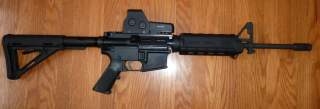China Ripped Off the M16A1 Rifle. The Only Question We Have Is Why?
Meet China's Norinco CQ Rifle.
Key Point: The gun is mysterious; why'd the Chinese manufacture it, why was it not given to their security services, and why has it been able to make its away across the world?
Some weapons are so ubiquitous they are manufactured even in countries one might not associate them with. One example of this is the M16 rifle series. In service with the U.S. Military for more than fifty years, it has fallen into the hands of many groups that were not originally issued them, such as the Viet Cong, communist guerillas in the Philippines, and now the Islamic State. Only one of America’s potential adversaries took the step of making their own M16s, however: that distinction belongs to China with the production of the CQ rifle.
The Cold War saw large numbers of M16 style rifles issued to America’s allies worldwide, from the South Vietnamese Army to the Israeli Defense Forces. Lightweight and reasonably effective once a series of embarrassing—and deadly—kinks were ironed out, the M16A1 rifle was also a visual symbol of a country’s alliance with the United States, just as the AK-47/M assault rifle was a symbol of support by the Soviet Union.
The M16 series rifle, adopted by the Pentagon 1965, was a gas operated, direct impingement weapon designed to fire the new 5.56-millimeter round. Weighing just seven pounds with a twenty round magazine, it was a handy weapon for ground forces facing both conventional, World War II-style warfare and counterinsurgency alike. The lighter rounds were easier to transport in bulk by helicopter, and the 5.56 seemingly had magical lethality against human-sized targets.
After the Vietnam War, the People’s Republic of China began manufacturing a number of American small arms that played a prominent role in the war. The M14 battle rifle, M16 assault rifle and M1911 .45 caliber handgun all went into production, likely the result of copies of the weapons handed over by the victorious People’s Army of Vietnam in 1975 to their Chinese allies. The surrender of South Vietnam flooded former North Vietnam with weapons which it distributed far and wide, sending captured military equipment as far away as the Soviet Union, East Germany and likely North Korea.
Semi-automatic versions of these weapons were exported to the United States starting in the 1980s. To the surprise of many, the Chinese copies became known for their sturdiness and reliability. The weapons were manufactured by the state-owned China North Industries Group Corporation Limited, or Norinco for short. Firearm imports from China were banned by the federal government in 1994. Although still banned in the United States, the weapons are available in Canada.
The Chinese copy of the M16A1 rifle, the CQ, is an odd weapon. It is a faithful copy of the original M16A1, with a handful of very visible differences. The handguard is ribbed and visually distinct from the M16A1’s smooth handguard. The flash hider is also different from the stock Colt flash hider. The buttstock has a cutout on the lower half whose purpose defies explanation. Perhaps most striking is the use of what appears to be an antiquated revolver-style pistol grip.
There are other differences. The CQ uses Type 6000-series aluminum alloy, which is lightweight but weaker and less corrosion-resistant than the M16A1’s Type 7075 aluminum. It is also less expensive and easier to mill. Internally, the CQ’s barrel features a 1 in 12-inch right-handed rifling twist rate. Rifling is designed to induce spin—and thus stability—on a bullet as it exits the barrel, and the rifling must match the particular bullet. In the CQ’s case, the 1 in 12-inch rifling is meant to stabilize the older 55 grain M193 round, not the more recent 62-grain SS109 armor piercing round or more recent bullets. Although the CQ will fire all of them, ballistic performance over distance will be degraded.
The original CQ rifle was a copy of the M16A1, and had a 20-inch barrel and fixed stock. The CQ-A carbine is a copy of the M4 carbine, with a 14.5-inch barrel and collapsible stock. Versions are also available with shorter 10-inch barrels and in the AK-47-compatible 7.62x39 caliber.
It is not clear why China produced the CQ rifle. The CQ was never issued to the People’s Liberation Army and was likely never seriously considered. The CQ has popped up in conflicts all over the globe, including the Syrian and Sudanese civil wars. Exactly who purchased these weapons—and why—is a good question. Like the question of why it was made, the CQ’s proliferation across the globe is another mystery behind this enigmatic rifle.
Kyle Mizokami is a writer based in San Francisco who has appeared in The Diplomat, Foreign Policy, War is Boring and The Daily Beast. In 2009 he co-founded the defense and security blog Japan Security Watch. This piece was originally featured in January 2019 and is being republished due to reader's interest.
Image: Wikipedia

